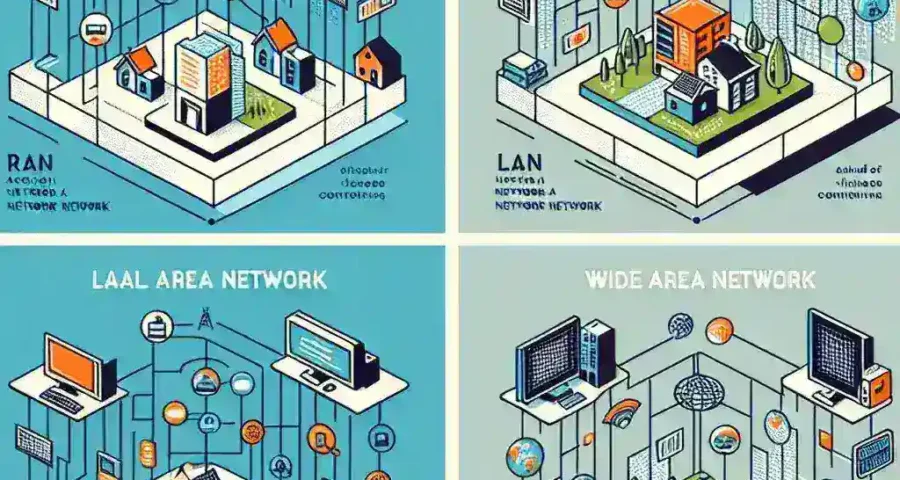In today’s interconnected world, computer networks are the backbone of communication and data exchange, enabling businesses and individuals to connect globally. Understanding the different types of computer networks can help in selecting the right network for specific needs, whether for personal use, business applications, or large-scale organizational purposes. Below, we delve into the various types of computer networks, their characteristics, and common use cases.
Types of Computer Networks
| Network Type | Full Form | Scope | Primary Use |
|---|---|---|---|
| LAN | Local Area Network | Small geographical area, like a home, office, or building | Connecting computers and devices in close proximity |
| WAN | Wide Area Network | Large geographical area, often nation-wide or international | Connecting multiple LANs over a broad area |
| MAN | Metropolitan Area Network | City or campus | Connecting multiple LANs within a specific area |
| CAN | Campus Area Network | Campus or military base | Connecting networks within a limited area |
| PAN | Personal Area Network | Very small area, typically around an individual | Bluetooth-enabled devices, personal gadgets |
| SAN | Storage Area Network | Data centers | Providing access to consolidated, block-level data storage |
Local Area Network (LAN)
A Local Area Network (LAN) is a network that covers a relatively small area, such as a home, school, office building, or campus. A LAN is characterized by its high data transfer rates and limited geographical range. Typically, devices connected within a LAN are physically close to each other, enabling fast communication and data exchange.
- Advantages: High speed, lower levels of data loss, and reduced costs due to shared resources.
- Example Applications: Home networks, office networks, and educational institutions.
Wide Area Network (WAN)
A Wide Area Network (WAN) spans a large geographical area, often across countries or continents. WANs are used to connect multiple LANs, allowing them to communicate and share resources no matter how far apart they are.
- Advantages: Enables global communication and resource sharing across vast distances.
- Example Applications: The Internet, multinational business networks.
Metropolitan Area Network (MAN)
A Metropolitan Area Network (MAN) covers a larger area than a LAN but is typically confined to a city or large campus. MANs provide efficient connectivity within a specific geographic area, making them suitable for organizations with multiple buildings in a single city.
- Advantages: High-speed connectivity over a larger area than LANs, often used for linking multiple LANs within a city.
- Example Applications: Municipal networks, university campuses.
Campus Area Network (CAN)
A Campus Area Network (CAN) typically spans multiple buildings within a limited area, such as a university campus or a military base. CANs are essentially a series of interconnected LANs, facilitating communication and resource sharing within a localized area.
- Advantages: Cost-effective way to connect multiple buildings within close proximity.
- Example Applications: University campuses, corporate campuses, military bases.
Personal Area Network (PAN)
A Personal Area Network (PAN) is used for data transmission among devices such as computers, smartphones, tablets, and other personal gadgets. Typically, the range of a PAN is limited to a single individual’s reach, making it ideal for short-range communication.
- Advantages: Convenience of connecting personal devices wirelessly.
- Example Applications: Bluetooth-enabled devices, smartwatches, personal gadgets.
Storage Area Network (SAN)
A Storage Area Network (SAN) is a specialized network that provides access to consolidated, block-level data storage. SANs are essential for large organizations that require centralized storage solutions to handle massive amounts of data effectively.
- Advantages: Provides high-speed access to storage, scalability, and centralized data management.
- Example Applications: Data centers, enterprise storage solutions.
Choosing the Right Network
Selecting the appropriate type of network depends on various factors such as the size of the area to be covered, the number of devices to be connected, required data transfer speeds, and specific use cases. Here is a brief guide to help make the decision:
- For Small Areas: If the network is for a home or a small office, a LAN or PAN might be the best choice due to their simplicity and cost-effectiveness.
- For Larger Areas: For connecting multiple buildings within a city or campus, a MAN or CAN would be more appropriate due to their extended range and high-speed connectivity.
- For Global Reach: When the network needs to span across cities, countries, or continents, a WAN is the definitive solution for enabling broad communication and resource sharing.
- For Specialized Storage Needs: Enterprises with extensive storage requirements should consider implementing a SAN for its centralized and high-speed data management capabilities.
By understanding the characteristics and advantages of each type of computer network, organizations and individuals can make informed decisions to optimize their connectivity solutions. As technology continues to evolve, the possibilities and capabilities of computer networks will undoubtedly expand, offering even more innovative ways to stay connected.


Leave a Reply